Researchers Look at Human Responses to ‘Cuteness’ in Social Media

Images via Bored Panda, Twitter
Could a kitten in your Instagram feed sway your cereal choice? If the cat has saucer-sized eyes, wears a tiny tuxedo and teeters on a wobbling box of day-glo frosted carbs, you might be more apt to add it to your shopping list, according to University of Maryland researchers.
Their ongoing “cuteness” study aims to better understand why a social media post makes us go “awwww,” and how that influences what we buy, “like” or even believe. It’s part of UMD’s Applied Research Laboratory for Intelligence and Security’s (ARLIS) Emotions in Social Media Project, a multidisciplinary research effort to examine how different emotions influence the spread of information campaigns. The project received funding from the U.S. Department of Defense Minerva Research Initiative and the Office of Naval Research.
“It’s fun, but it’s not frivolous,” said Susannah Paletz, associate professor in the College of Information Studies and principal investigator. “As enjoyable as it is to discover in your Twitter feed, we know cuteness is also used to deliberately manipulate your feelings. And it works.”
 The “cute” study offers 15 quantifiable attributes, including visual characteristics, behavior and linguistic cues, to create what researchers call a Cuteness Attributes Taxonomy. In the study, published in Frontiers in Psychology, trained annotators pored over 1,800 social posts and assigned codes to images or strings of words, from baby behavior to high-pitched voices, while also separately measuring annotators’ emotional responses.
The “cute” study offers 15 quantifiable attributes, including visual characteristics, behavior and linguistic cues, to create what researchers call a Cuteness Attributes Taxonomy. In the study, published in Frontiers in Psychology, trained annotators pored over 1,800 social posts and assigned codes to images or strings of words, from baby behavior to high-pitched voices, while also separately measuring annotators’ emotional responses.
“It’s a time-consuming process, but one that results in gold-standard data,” said Ewa Golonka, associate research scientist at ARLIS, who also serves as the team’s task publications lead on this topic.
The team hopes to use its data to examine whether an onslaught of concentrated cuteness predicts user engagement in social media, like the number of shares, comments or likes; this research includes emotion evoked by cute content, for which they also developed measures. Research on a broader emotional spectrum—23 discrete emotions with fuzzy boundaries identified by the team, from disgust to wonder—and how patterns of emotions influence social media sharing, is also underway.
Below, Golonka and Paletz discuss the anatomy of cute, why it matters and the dumpster-diving-cat-turned-labor-activist that became a viral sensation:
What makes something cute? Is there a recipe for achieving ultimate cuteness?
Golonka: Yes, there’s a whole list that we can refer to when determining if something is cute. The main one is called “baby schema”: large head, chubby cheeks, small nose and a round body shape combined with cute behavior, like clumsy movements or being helpless and vulnerable. There’s cute talk, with a high pitch or certain vocabulary. Also, there’s a concept called cuteness by contrast, where the sense of cuteness is created by contrasting attributes, like a gorilla with a baby. And there are also features that make cute objects even cuter; for example, cute animals interacting is cuter than if they don’t interact.
 What sort of implications does this research have for society, but also for things like disinformation and national security?
What sort of implications does this research have for society, but also for things like disinformation and national security?
Golonka: We know that cuteness affects people’s brains, emotions and behaviors. So, all of this can have huge implications. We know that individuals and organizations draw on cute content to persuade: for example, to buy products, convey public service announcements, donate money by creating empathy and compassion, even reduce meat consumption.
Paletz: This does have national security implications. Years ago, ISIS was using kittens to soften their persona and help with recruitment. More recently, animals have made their way into anti-Russian social posts out of Ukraine, including cats dressed in military uniforms.
What is your favorite example of an organization using “cuteness” to forward an agenda?
Paletz: In 2021, a Reddit thread went viral about an “office” cat named Jorts and attempts to train him by employees. He was portrayed as this lovable but not terribly smart cat who was constantly getting into scrapes, and who ultimately was at the center of a workplace incident that involved Human Resources. Eventually, the person behind the thread launched a Twitter account for Jorts that’s told from the cat’s perspective. But what’s happened over time is it’s become this great mix of cute cat tweets and a powerful platform for labor activism. It’s amazing.
Do you have any tips for people who want to ramp up the cuteness of their social posts?
Golonka: It’s about building as many layers of cuteness as possible. Mine would be a bunch of baby goats in pajamas running around and playing together. Then add some cute talk and an emoji… and then sprinkle your message somewhere. And you are good to go.
If cuteness can be used nefariously, can we ever trust a baby animal post again?
Paletz: One of the big takeaways from our work is that there is a lot of really toxic discourse and a lot of anger and hate on social media; so even if cuteness is used deliberately to manipulate—like when ISIS poses with kittens—it’s nicer than the alternative.
The original article by Maggie Haslam was published May 10, 2023 in UMD’s publication, Maryland Today.